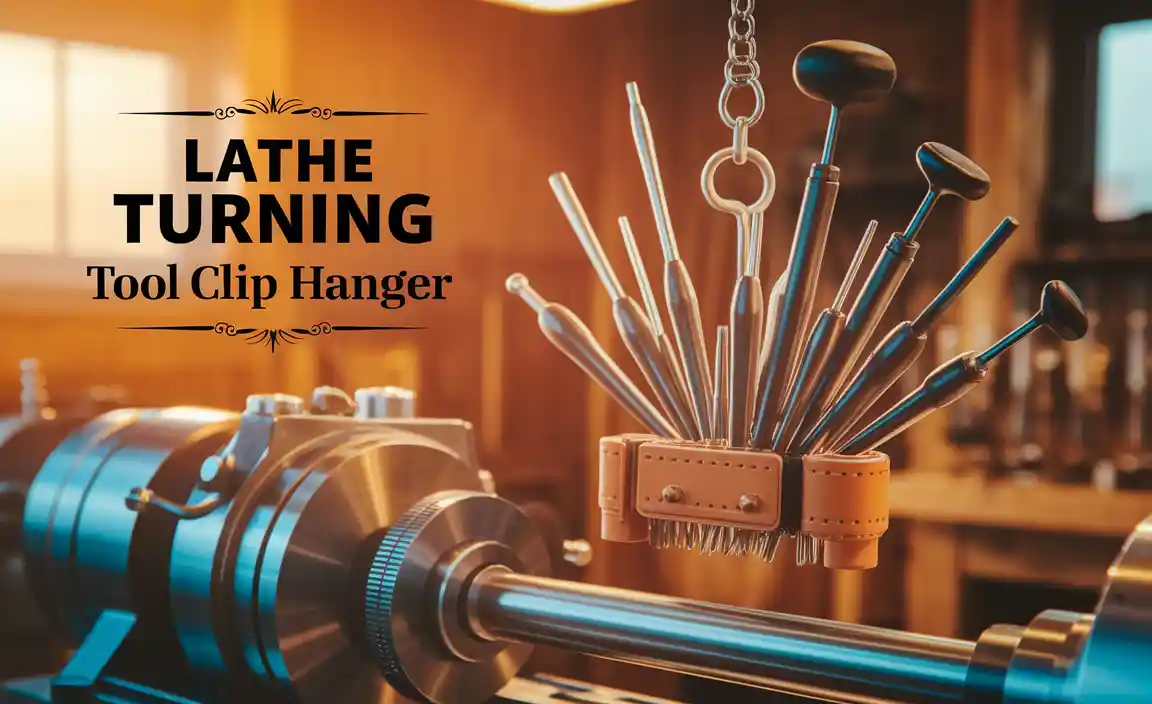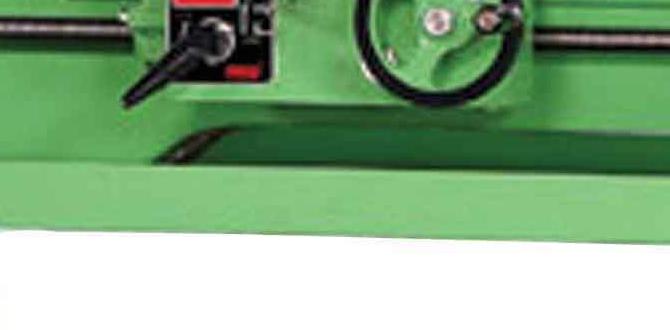Lathe chuck for drill: The best chuck securely holds your drill bits for precise drilling on your lathe. Choose one matching your lathe’s spindle size and offering reliable grip for safe, accurate work.
Ever tried to drill a perfectly centered hole in a workpiece on your lathe, only to have the drill bit wobble or slip? It’s a common frustration for new machinists and woodworkers alike. Getting a reliable grip on your drill bit is key to accuracy and safety. That’s where a lathe chuck designed for holding drill bits comes in. It’s a simple tool that makes a huge difference.
This guide is here to help you understand what to look for. We’ll break down the options, explain the important features, and guide you through making the right choice for your lathe. No jargon, just clear advice to get you drilling with confidence.
What is a Lathe Chuck for Drills?
At its core, a lathe chuck for drills is a specialized attachment for your lathe that securely grips drill bits. Unlike the standard three-jaw or four-jaw chucks typically used for holding the main workpiece, these chucks are designed to hold cylindrical shanks of drill bits with precision. They typically use a key mechanism or a keyless rotating collar to tighten around the drill bit shank, ensuring it spins true and centered.
Think of it as a small, but mighty, vise that attaches to your lathe’s headstock (or tailstock, depending on how you use it). This allows you to use your lathe’s consistent rotation to create clean, accurate holes in the material you’re working on. It’s essential for tasks like drilling center holes for mounting longer stock, creating precise access holes, or any operation where a stable, centered drill bit is a must.
Why Use a Dedicated Lathe Chuck for Drills?
You might wonder why you can’t just use your main lathe chuck to hold a drill bit shank. While it’s sometimes possible for larger bits, it’s generally not ideal and can even be dangerous.
- Accuracy: Standard lathe chucks are designed to hold round or irregular workpieces. Their jaw geometry isn’t optimized for the small, cylindrical shanks of drill bits, leading to off-center spinning and inaccurate holes.
- Grip Security: Drill bits have smooth shanks. Standard chuck jaws might not get a sufficiently strong grip, especially under the torque of drilling. This can lead to the bit slipping, damaging both the bit and your workpiece, and posing a safety hazard.
- Damage to Tooling: Repeatedly trying to grip small drill bit shanks in a large lathe chuck can damage the jaws of your more expensive main chuck.
- Versatility: A dedicated drill chuck can often hold a range of drill bit shank sizes, providing a more precise and adaptable solution than trying to jury-rig your main chuck.
Types of Lathe Drill Chucks
When you’re looking for a lathe chuck for drills, you’ll primarily encounter two main types, distinguished by their operation and how they grip the drill bit:
1. Keyed Drill Chucks
These are probably the most common type you’ll see. They feature multiple jaws (usually three) that are tightened and loosened using a small, gear-like key that engages with a geared collar on the chuck body. You insert the key into different points around the circumference of the chuck and turn it to adjust the jaws.
Pros:
- Positive Grip: When tightened properly with the key, they offer a very secure grip on the drill bit shank.
- Durability: Generally robust and built to last.
- Cost-Effective: Often more affordable than keyless versions.
Cons:
- Slower Operation: It takes more time and fiddling with the key to insert and remove drill bits.
- Lost Keys: The key can be easily misplaced or lost.
2. Keyless Drill Chucks
Keyless chucks offer a more convenient and faster way to change drill bits. They have a rotating collar that you simply twist by hand to tighten or loosen the jaws. The internal gearing provides leverage, making it easy to achieve a firm grip.
Pros:
- Speed and Convenience: Much faster to swap drill bits, saving valuable time during a project.
- No Lost Keys: The keyless design means you won’t be searching for a missing tool.
- Good Grip: Modern keyless chucks provide a strong and reliable grip.
Cons:
- Cost: Typically more expensive than keyed chucks.
- Potential for Slippage (Older/Cheaper Models): Some very basic or older keyless chucks might not offer as secure a grip as a well-tightened keyed chuck, especially under heavy load.
Key Considerations When Buying
Choosing the right lathe chuck for your drill bits involves looking at several important factors. Getting these right ensures compatibility, functionality, and safety. Here’s what you need to think about:
1. Mounting Type and Size
This is the most CRITICAL factor. Your drill chuck needs to attach securely to your lathe. There are several common mounting methods, and you need to match it to your lathe’s spindle thread or taper.
- Threaded Mount: This is very common. Your lathe spindle will have a thread (e.g., 1″ x 8 TPI, 3/4″ x 10 TPI, M33 x 3.5). The drill chuck will have a corresponding female thread that screws onto it. Make sure you know your lathe’s spindle thread size and pitch. Many woodworking lathes use a 1″ x 8 TPI thread.
- Morse Taper (MT): Many metalworking lathes use Morse tapers (MT1, MT2, MT3, MT4, etc.) for their spindles and tailstocks. If your lathe has a female Morse taper in the headstock (less common for chuck mounting, more common for tailstock tools) or if you’re planning to use this chuck in your tailstock, you might need a drill chuck with a male Morse taper shank. For example, a #2 Morse Taper shank (MT2) drill chuck.
- Quick-Change Systems: Some modern lathes, especially in industrial settings, might use proprietary quick-change systems. Ensure compatibility.
How to Find Your Lathe’s Spindle Thread or Taper:
- Check your lathe’s manual – this is the best source.
- Measure the diameter and count the threads per inch (TPI) if it’s threaded. A thread gauge can help.
- For Morse Tapers, common sizes are MT1 through MT4. You can often identify them by their size and taper angle. You can find charts online to help measure and identify Morse Taper sizes. For example, you can refer to the Teng Tools guide to Morse taper sizes for visual reference.
2. Capacity (Jaw Opening Range)
The capacity refers to the range of drill bit shank diameters the chuck can securely hold. This is usually given in millimeters (mm) or inches (in).
Common Capacities:
- Small Chucks: Might range from 1.5mm to 10mm (approx. 1/16″ to 3/8″).
- Medium Chucks: Often range from 3mm to 13mm (approx. 1/8″ to 1/2″).
- Large Chucks: Can go up to 16mm, 20mm, or even larger.
What You Need: Think about the typical size of drill bits you use most often. If you primarily work with smaller projects and smaller drill bits, a smaller capacity chuck might suffice. If you anticipate drilling larger holes or using larger bits, opt for a chuck with a wider capacity range. It’s often economical to buy a chuck that covers the majority of your needs rather than having multiple chucks.
3. Accuracy and Runout
Runout is the amount of wobble or deviation from a true center when the chuck and bit are spinning. Lower runout means better accuracy. For precision work, you want a chuck with minimal runout.
High-quality chucks from reputable brands will specify their runout tolerance, often measured in thousandths of an inch or millimeters. While beginners might not need laboratory-grade precision, a chuck with less than 0.005″ (or about 0.1mm) of runout is generally considered very good for most workshop tasks.
4. Build Quality and Materials
The materials and overall construction of the chuck directly impact its durability, accuracy, and longevity. Look for:
- Hardened Jaws: This ensures the jaws can withstand repeated clamping without deforming.
- Precision Machining: Well-machined parts mean less play and better accuracy.
- Corrosion Resistance: A protective coating or material helps prevent rust, especially if your workshop environment is humid.
Reputable brands often invest more in these aspects, so while they might cost more upfront, they usually provide better performance and last longer.
5. Keyless vs. Keyed
As discussed earlier, this comes down to your preference for speed versus cost and a completely positive mechanical lock. If you change bits frequently, a keyless chuck is a time-saver. If budget is a primary concern or you prioritize the absolute most secure grip, a keyed chuck might be better. For most home hobbyists, a good quality keyless chuck offers a great balance.
Mounting Your Drill Chuck on the Lathe
The process for mounting your drill chuck depends on its type and your lathe’s spindle. Here’s a general guide:
For Threaded Mounts
- Safety First: Ensure your lathe is turned off and the power is disconnected. Wear safety glasses.
- Clean the Spindle: Make sure the spindle threads are clean and free of debris or old grease. A clean thread ensures a smooth, secure fit.
- Thread the Chuck On: Carefully thread the drill chuck onto the lathe’s spindle. Many chucks thread on clockwise. It should screw on smoothly. Don’t force it.
- Tighten Firmly: Once threaded on, tighten the chuck against the spindle shoulder. This usually involves a final snug turn. Some chucks have a provision for a pin or tool to help tighten them against a drive pin on the spindle face, especially on wood lathes.
- Check for Security: Give the chuck a firm shake to ensure it’s securely attached.
For Morse Taper Mounts
- Safety First: Ensure your lathe is turned off and the power is disconnected. Wear safety glasses.
- Clean the Taper: The Morse taper on the lathe spindle (or tailstock) and the taper on the chuck shank must be perfectly clean and free of any dirt, grease, or burrs.
- Insert the Shank: Align the taper on the chuck shank with the socket in the spindle/tailstock.
- Seat the Taper: Gently push the chuck into the socket. For a snug fit, you might need to tap it lightly. Some tool holders have a tang (a protruding part) that allows you to use a knockout bar through the tailstock or a drift through a slot on the headstock to remove them. If your chuck has this, ensure it’s seated correctly for a secure fit and not engaged with the knockout mechanism.
- Check for Security: Ensure the chuck is seated firmly and doesn’t wobble.
Important Note: For wood lathes, it’s common to mount a drill chuck in the tailstock and use it to drill into a stationary workpiece held in the headstock chuck. For metal lathes, you might mount a drill chuck directly to the headstock spindle (though this is less common than using a tailstock-mounted drill or a live center for drilling) or use it in the tailstock for cross-drilling operations.
How to Use Your Drill Chuck Safely
Safety is paramount when operating any machine tool. Using a drill chuck on a lathe is no different. Follow these guidelines:
- Read Your Manuals: Always refer to your lathe’s and chuck’s operating manuals for specific instructions and safety warnings.
- Wear Safety Glasses: This is non-negotiable. Always wear ANSI- Z87.1 compliant safety glasses or a face shield.
- Secure Drill Bit Properly: Ensure the drill bit is fully inserted into the chuck and tightened securely. For keyed chucks, use the key to snug it up evenly. For keyless, ensure the collar is tight.
- Center Punch Your Mark: Before drilling, use a center punch to create a small indent on your workpiece where you want to drill. This helps the drill bit start in the correct place and prevents “walking.”
- Start Slow: Begin drilling at a slow spindle speed, especially when breaking into the material. Gradually increase speed as needed, but always stay within safe operating RPMs for both the lathe and the drill bit. Consult resources like the Carbide Process Chart for Drill Speeds and Feeds for guidance.
- Apply Steady Feed Pressure: Push the drill into the workpiece with a steady, consistent pressure. Don’t force it. Let the cutting edge do the work.
- Clear Chips Regularly: For deeper holes, periodically retract the drill to clear chips. This prevents the hole from becoming clogged, which can cause the drill to break or bind.
- Eject Chips Safely: Ensure chips are directed away from you and others. Use a brush or compressed air carefully, and never use your hands to clear chips from a spinning workpiece.
- Check for Wobble: If you notice excessive wobble or vibration from the drill bit while it’s spinning, stop the lathe immediately. The bit may not be securely gripped, or the chuck itself might have excessive runout.
- Never Reach Over a Spinning Lathe: Keep hands and loose clothing away from moving parts.
Choosing the Right Size and Type: A Quick Comparison
To help you visualize the differences and make a decision, here’s a table summarizing key points for keyed versus keyless drill chucks:
| Feature | Keyed Drill Chuck | Keyless Drill Chuck |
|---|---|---|
| Grip Mechanism | Uses a special key with gears to tighten jaws. | Rotates a collar by hand to tighten jaws. |
| Speed of Bit Change | Slower, requires locating and using the key. | Faster and more convenient. |
| Grip Security | Generally very secure and positive lock. | Good to very good, especially on quality models. |
| Convenience | Less convenient due to key management. | High convenience. |
| Cost | Typically more affordable. | Typically more expensive. |
| Likelihood of Misplacing Parts | Higher with the key. | Lower (no separate key). |
| Best For | Budget-conscious users, those who prioritize absolute grip security, and less frequent bit changes. | Users who value speed, convenience, and frequent bit changes. |
When selecting capacity, generally aim for a chuck that covers your most common drill bit sizes. For instance, a common and versatile capacity for many hobbyists is 3mm to 13mm (1/8″ to 1/2″). If you frequently use very small drill bits (under 3mm) or very large ones (over 13mm), you might consider a specialized chuck, but a good all-around chuck will serve most needs.
Popular Brands and Where to Buy
When it comes to buying tools, reputation matters. Investing in a well-known brand often means better quality control






